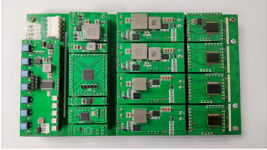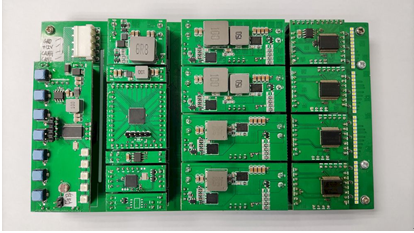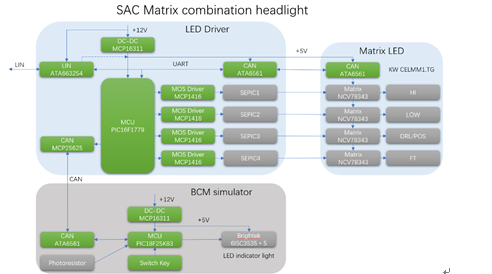
Dalian Dapinjia Group launches CAN/LIN communication matrix headlight solution based on Microchip, Onsemi and OSRAM products
On September 15, 2021, Dalian General Holdings, a leading semiconductor component distributor dedicated to the Asia-Pacific market, announced that its subsidiary Pinjia has launched products based on Microchip’s PIC16F1779, onsemi’s NCV78343 and OSRAM. ) LED CAN/LIN communication matrix headlight solution.

Figure 1 – The physical diagram of Dalian Dapinjia and a number of well-known companies to launch CAN/LIN communication matrix headlight solutions
With the continuous improvement of people’s requirements for automobiles, more and more Electronic control devices are applied to automobiles. While these electronic control devices improve the comfort of automobiles, they also lead to the increasing complexity of automobile wiring harnesses. To this end, Dalian Dapinjia has launched a CAN/LIN communication matrix headlight solution based on Microchip, onsemi and OSRAM products, aiming to replace the cumbersome field wiring with serial communication network to solve the above problems.

Figure 2 – The block diagram of Dalian Dapinjia and a number of well-known companies to launch CAN/LIN communication matrix headlight solutions
The core part of this solution adopts Microchip’s PIC16F1779 MCU, which integrates peripheral modules independent of the core to realize switching power supply control, logic control and communication functions. Significantly increased flexibility compared to pure analog or ASIC implementations. And the PIC16F1779 can independently control up to four LED channels, which is a unique capability that most LED driver controllers do not have, especially suitable for combined headlight/taillight design. In addition, this solution also integrates onsemi’s NCV78343 matrix control chip and OSRAM’s excellent LED products, which will further improve the performance of CAN/LIN communication matrix headlights.
Figure 3 – The application diagram of Dalian Dapinjia and many well-known enterprises to launch the CAN/LIN communication matrix headlight solution
As an excellent communication matrix headlight solution, it integrates four LED dimming engines on a single MCU, which can realize up to four completely independent constant current driving of LED light strings, and adopts SEPIC buck-boost topology , a wider range of applications. For different LED loads, it is only necessary to adjust the output voltage and current in software.
The LED dimming engine consists of analog peripherals integrated in the microcontroller, and these modules are connected through the MCC configuration to form four independent LED dimming drivers. Once configured, the system can control the switch-mode power converter on its own with little or no central processing unit (CPU) intervention, which frees the CPU to perform other important tasks such as monitoring functions, communication functions, or added intelligence in the system Features.
Core technical advantages:
PIC16F1779 single hybrid power MCU (built-in PRG slope compensation, OPA op amp, COMP comparator, COG complementary waveform generator, DAC, ADC, USART and other peripherals), can realize four-channel SEPIC buck-boost constant current drive, CAN/ LIN protocol processing, matrix chip animation control;
Adopt PCMC peak current mode to quickly respond to load changes, SEPIC topology to achieve buck-boost, single-channel constant current up to 1A (pay attention to LED heat dissipation), support PWM dimming;
Hardware-level overvoltage protection, automatically shuts down PWM output when overvoltage occurs;
Detect the terminal voltage of the LED light string, can judge the LED open circuit, short circuit and other faults, and feed it back to the BCM simulator through CAN communication to Display on the indicator light;
NTC thermistor detects LED temperature to realize overheat protection and over-temperature derating operation;
Adopt photoresistor to detect ambient light intensity to realize automatic headlight function;
Simulate BCM to send CAN commands to control headlights on and off, dimming, switch animation, matrix control, reset, voltage/status/fault feedback;
Four-way drive realizes combined headlight functions, including high beam, low beam, daytime running lights, position lights, and turn signals. (Daytime running lights and position lights share the third group of drivers, and the brightness is adjusted by software);
NCV78343 UART Over CAN communication can support long distance transmission. Automatic addressing at power-on, 4 cascades to achieve independent control of 48 (12*4) LEDs;
Modular design, easy to modify and replace modules to match different functional requirements;
Support MPLAB X IDE MCC graphical code configuration plug-in, graphically generate the underlying driver, and develop quickly;
The well-designed SAC_CAN_LED_Lib SDK development kit provides functions such as building four-channel PCMC constant voltage/constant current driver, PWM dimming, MCP25625 CAN driver, USART driver, frequency jittering, etc., and provides API interfaces;
After signing the NDA, the schematic diagram, PCB diagram, bill of materials, software sample source code, SDK development kit, and CAN communication protocol can be provided.
Program Specifications:
PWM frequency: 333KHz (250KHz~500KHz software adjustable);
Conversion efficiency: 82%~85%;
Over temperature protection: greater than 112.5℃, derate to 80%, greater than 122.5℃, derate to 70%. (software adjustable);
LED fault detection: support;
LIN communication: support (use MCC to generate code);
CAN communication: support (driver API is provided in SDK), support control, status, fault feedback;
Switch control: support;
?Digital jitter: support (software adjustable);
Soft start: support (software adjustable);
Input anti-reverse connection: support;
Current resolution: 6.66666667mA (related to the value of the LED current sampling resistor, the larger the resistance, the higher the resolution);
Maximum power: 40W x 4 channels;
Input voltage: DC 9V~24V;
Matrix control: NCV78343 maximum 1.5A*12 LED*4 channels;
Animation effects: boot animation, shutdown animation.
The Links: NL8060BC2635AD DMF660N BUY-IGBT



